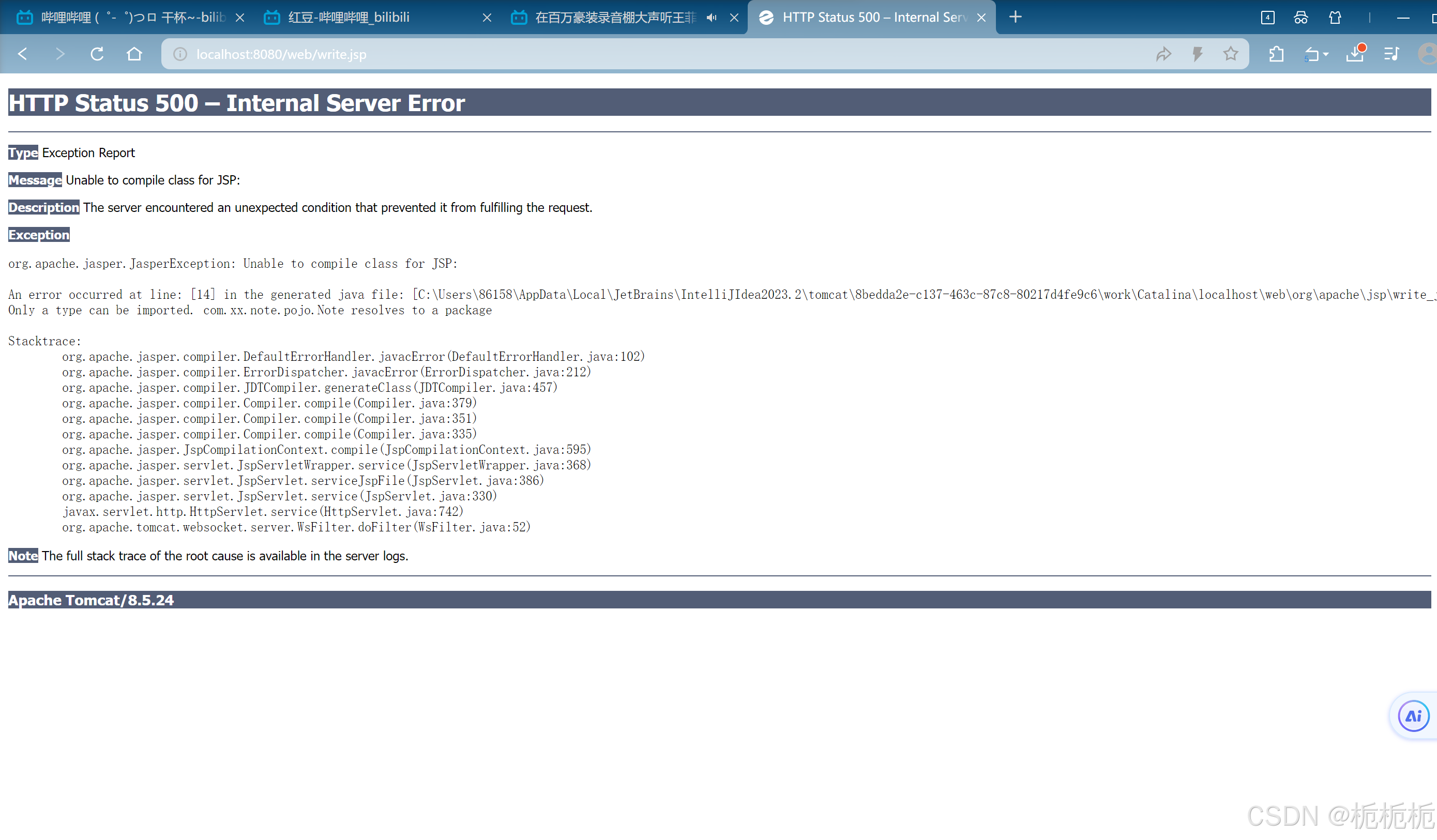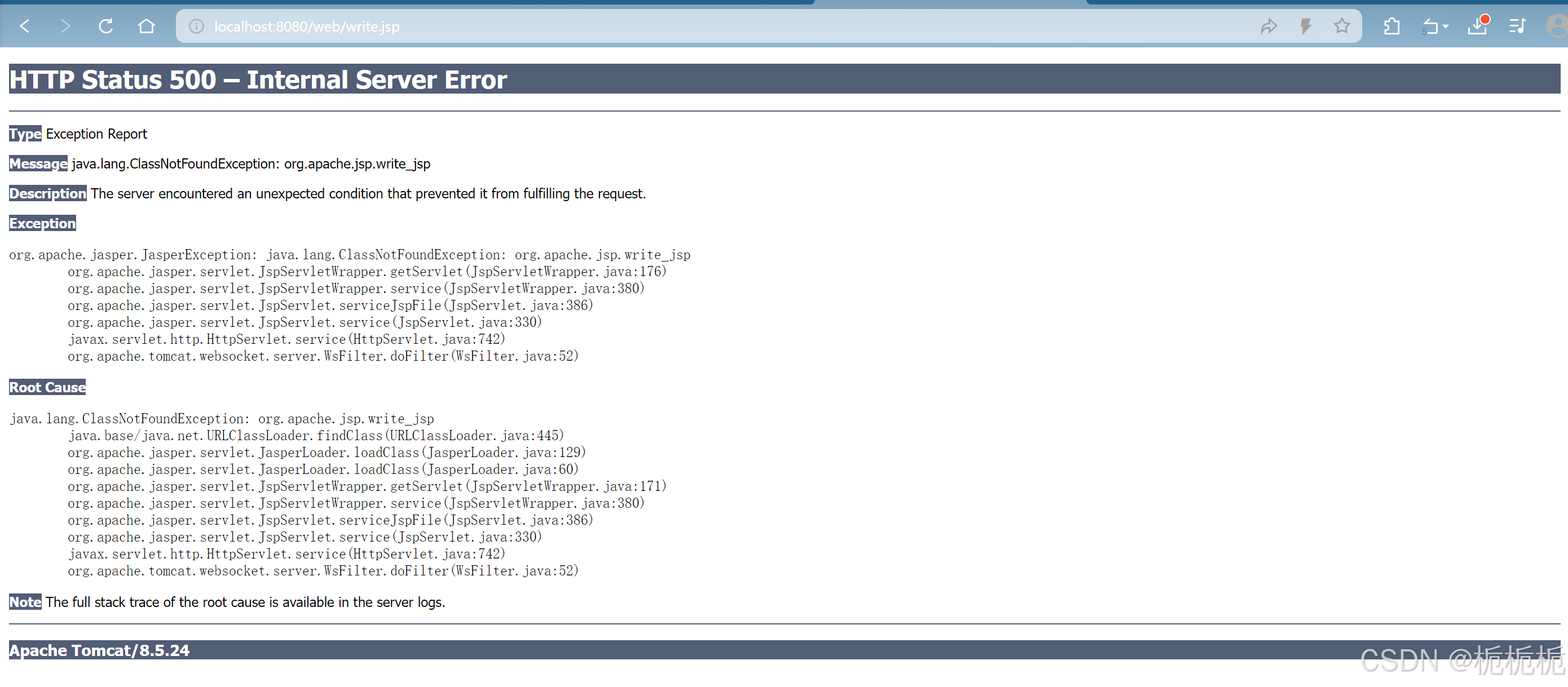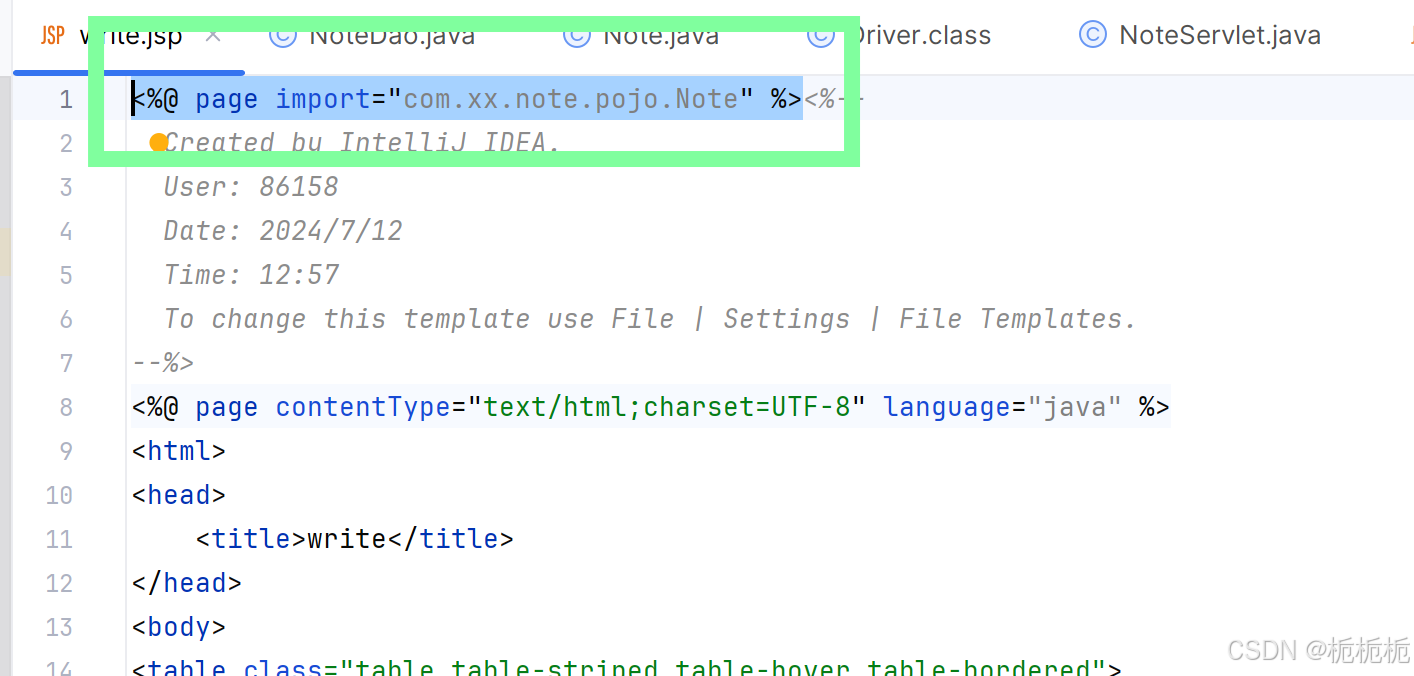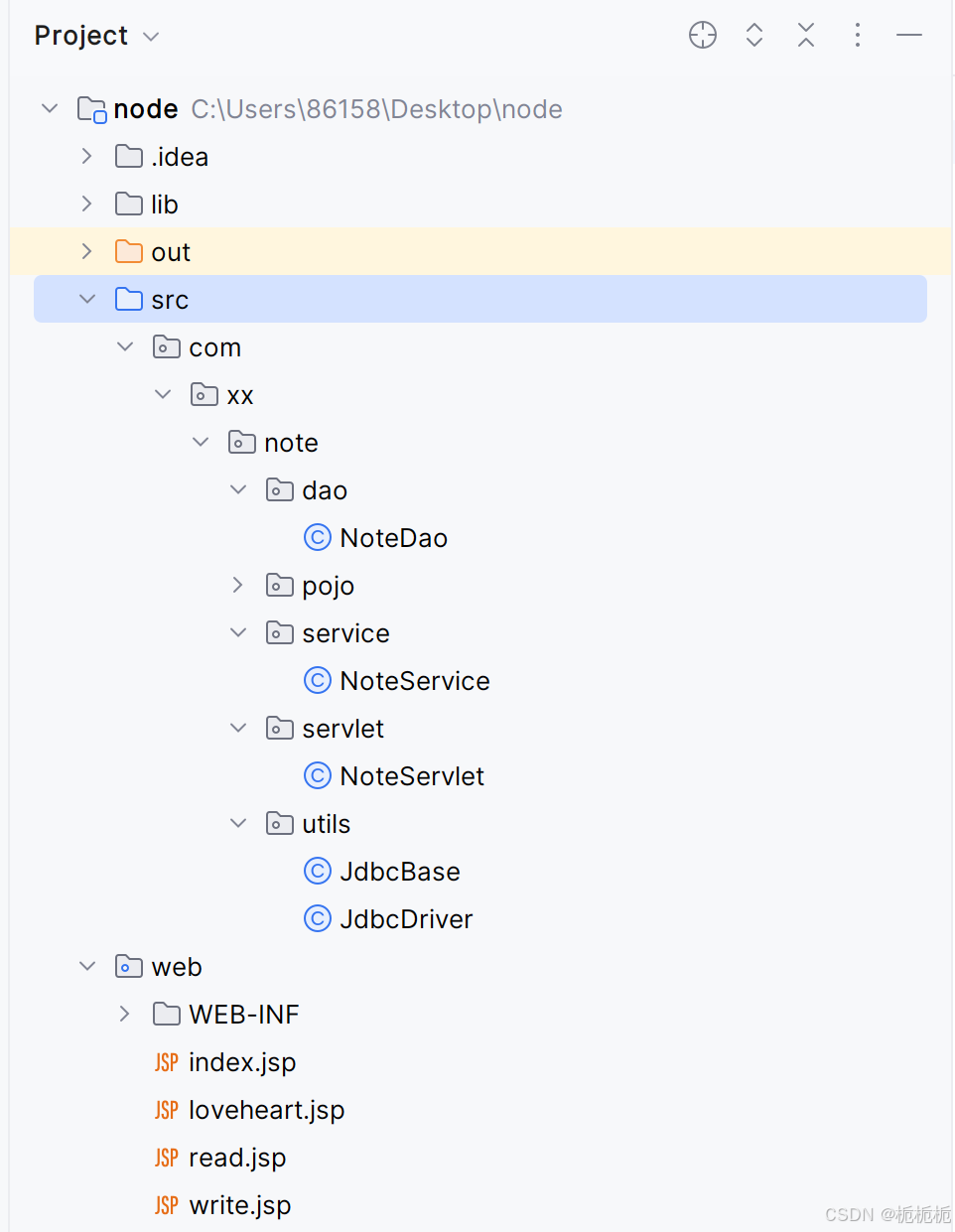vo.setId(rs.getLong("id"))什么意思?
vo.setId(rs.getLong("id"));这行代码是在Java中使用ResultSet对象(通常用于从数据库中检索数据)获取一个名为"id"的列,并将其作为long类型设置为一个对象的ID属性。通常,这种代码出现在从数据库中提取数据并将其映射到Java对象的过程中。
servlet?
衔接前后端。
servlet是Java编程语言的一个规范,用于处理在Web服务器上运行的Java应用程序的请求和响应。Servlet通常用于创建动态Web页面,进行用户输入验证,处理表单数据,管理会话等操作。它可以与JavaServer Pages(JSP)一起使用,协同提供强大的Web应用程序开发能力。
request.getSession().setAttribute("no", no);啥意思?
这行代码是在Java servlet中将一个名为"no"的属性设置为"no"。在HTTP会话期间,该属性会与特定的值关联。这种做法通常用于在用户与应用程序的交互过程中保留数据。
重定向是什么意思?
重定向(Redirect)是指在Web开发中,服务器接收到客户端(浏览器)的请求后,返回一个特殊的响应码,告诉浏览器去请求另一个URL。这样浏览器会根据这个新的URL发起新的请求,并加载显示新的页面内容。重定向可以用来跳转到另一个页面、处理表单提交后的跳转、处理登录后的跳转等操作。在Java Servlet中,可以使用response.sendRedirect()方法来实现重定向。
序列化和反序列化
Java序列化就是指把Java对象转换为字节序列的过程
Java反序列化就是指把字节序列恢复为Java对象的过程。
对象状态的保存和重建。
只有实现了Serializable或者Externalizable接口的类的对象才能被序列化为字节序列。(序列化)
import java.io.Serializable;Jsp使用<c:forEach>遍历List集合
<c:forEach items="${list}" var="no"> <tr class="index-content-table-td"> <td>${no.name}</td> <td>${no.content}</td> <td>${no.date}</td> </tr> </c:forEach><table class="table table-striped table-hover table-bordered"> <thead> <tr class="index-content-table-th"> <th>寄信人</th> <th>内容</th> <th>日期</th> </tr> </thead> <tbody> <c:forEach items="${list}" var="no"> <tr class="index-content-table-td"> <td>${no.name}</td> <td>${no.content}</td> <td>${no.date}</td> </tr> </c:forEach> </tbody> </table>items="${list}" //list集合:集合里有很多对象 var="no" //遍历到的那一个对象的别名result.put("list", list)?
result.put("list", list);<c:forEach items="${list}" var="vo">?
<c:forEach items="${list}" var="vo">foreach标签遍历后端传来的数据。
总结之jstl标签:c:foreach嵌套循环的实现——(items值处理)_jsp 把<foreach>标签拼接在字符串中-CSDN博客
${list}通常是一个从后端Servlet传递到前端页面的属性值。
后端Servlet会将数据准备好并存储在请求(request)属性中,然后将请求转发给JSP页面。在JSP页面中,您可以通过EL表达式${list}来访问这个名为list的属性。
检查后端Servlet的代码,看一下它是如何设置list属性的。通常会使用类似于request.setAttribute("list", dataList);这样的语句将数据存储到请求属性中。然后在JSP页面中,通过${list}来获取这些数据并在页面上展示。
response.sendRedirect("dinggou_" + to + ".jsp");?
response.sendRedirect("dinggou_" + to + ".jsp");response.sendRedirect("dinggou_list.jsp");JSP页面通过response.sendRedirect()方法跳转。
request.setAttribute(String name, Object value) 和 request.getSession().setAttribute(String name, Object value)
都是在Java Web开发中用于设置属性的方法。
如果数据只需要在当前请求中传递,使用 request.setAttribute();如果需要跨多个请求或页面保持数据,使用 request.getSession().setAttribute()。
代码
private void redirectList(HttpServletRequest request, HttpServletResponse response) throws IOException { //查询列和关键字 String searchColumn = request.getParameter("searchColumn"); String keyword = request.getParameter("keyword"); Map<String, Object> params = new HashMap();//用来保存控制层传进来的参数(查询条件) params.put("searchColumn", searchColumn);//要查询的列 params.put("keyword", keyword/*keyword != null ? new String(keyword.getBytes("ISO-8859-1"), "UTF-8") : null*/);//查询的关键字 NoticeService noticeService = new NoticeServiceImpl(); Map<String, Object> map = noticeService.list(params); request.getSession().setAttribute("list", map.get("list")); Integer totalRecord = (Integer) map.get("totalCount");//根据查询条件取出对应的总记录数,用于分页 String pageNum = request.getParameter("pageNum");//封装分页参数 com.demo.util.PageBean<Object> pb = new com.demo.util.PageBean(Integer.valueOf(pageNum != null ? pageNum : "1"), totalRecord); params.put("startIndex", pb.getStartIndex()); params.put("pageSize", pb.getPageSize()); List list = (List) noticeService.list(params).get("list");//根据分页参数startIndex、pageSize查询出来的最终结果list pb.setServlet("NoticeServlet"); pb.setSearchColumn(searchColumn); pb.setKeyword(keyword); pb.setList(list); request.getSession().setAttribute("pageBean", pb); request.getSession().setAttribute("list", pb.getList()); response.sendRedirect("notice_list.jsp"); }这段代码是一个方法,其目的是处理请求并重定向到一个名为`notice_list.jsp`的页面。解释代码的主要部分:
1. **获取请求参数:**
- 通过`request.getParameter("searchColumn")`和`request.getParameter("keyword")`获取请求中的参数`searchColumn`和`keyword`。
2. **设置查询条件:**
- 将请求中的搜索列和关键字保存在一个`Map<String, Object>`对象`params`中。
3. **调用服务层方法:**
- 创建一个`NoticeService`服务类的实例,并调用其中的`list(params)`方法获取数据,返回一个包含查询结果的`Map<String, Object>`对象`map`。
4. **处理分页数据:**
- 从`map`中获取总记录数`totalRecord`,并根据页面参数`pageNum`来设定分页参数。然后再次调用`list(params)`方法获取分页后的数据列表`list`。
5. **设置分页Bean和列表数据:**
- 创建一个分页Bean对象`pb`,设置相关属性并将根据分页参数查询得到的数据列表`list`存入其中。
6. **保存数据到会话:**
- 将整个分页Bean对象`pb`和数据列表`list`分别保存在当前会话的属性中,以便在重定向后的页面中使用。
7. **重定向到页面:**
- 最后通过`response.sendRedirect("notice_list.jsp")`将请求重定向到名为`notice_list.jsp`的页面。
综上所述,这段代码的功能是根据用户提交的查询条件进行数据查询,并在列表页面进行分页展示。
增加数据库的代码
public void addNote(Note note) { try { Connection c = JdbcBase.getConnection(); String sql = "INSERT INTO t_notice (name, content, date) VALUES (?, ?, ?)"; PreparedStatement ps = c.prepareStatement(sql); ps.setString(1, note.getName()); ps.setString(2, note.getContent()); ps.setDate(3, new Date(note.getDate().getTime())); int rowsAffected = ps.executeUpdate(); if (rowsAffected > 0) { System.out.println("Note added successfully"); } else { System.out.println("Failed to add note"); } ps.close(); c.close(); } catch (SQLException e) { e.printStackTrace(); } }展示数据库的代码
public void displayAllNotes() { try { Connection c = JdbcBase.getConnection(); Statement stmt = c.createStatement(); String sql = "SELECT * FROM t_notice"; ResultSet rs = stmt.executeQuery(sql); System.out.println("----- All Notes -----"); while (rs.next()) { int id = rs.getInt("id"); String name = rs.getString("name"); String content = rs.getString("content"); Date date = rs.getDate("date"); System.out.println("ID: " + id); System.out.println("Name: " + name); System.out.println("Content: " + content); System.out.println("Date: " + date); System.out.println("---------------------"); } rs.close(); stmt.close(); c.close(); } catch (SQLException e) { e.printStackTrace(); } }进度条
加了段代码突然500


刚刚发现去掉这个就没500了

进度条到这里,记录一下。


list里没有接到note对象???
